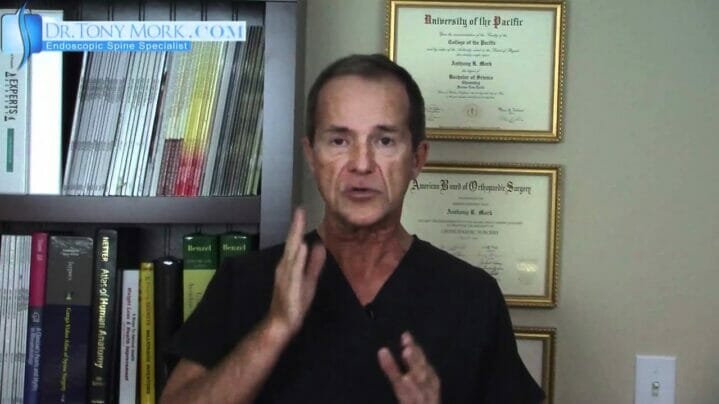Facet Joint
Let’s talk about facet joint syndrome or spinal arthritis. This condition becomes more common with age. It is not a young person’s disease; it is an older person’s disease, and it is progressive. It probably doesn’t exist when younger, but can account for 40% of low back pain complaints as one gets into their 70s and 80s. The problem is as a result of the facet degeneration. The facet joints are the guiding joints on the posterior side or back of the spine. They are located a little off to the sides from the midline.
I think that it is easy to see people getting shorter with age. One of the reasons we get shorter is because the intervertebral discs lose their water content. When that happens, the facet joints that started with perfect alignment get off center. When they get off center, facet degeneration can occur.
Why the facet joints hurt
Let’s talk a little bit about why the facet joints would hurt. The facet joints are actually lined with synovial tissue, which has a sensory nerve supply. In addition, a capsule that has a rich sensory nerve supply covers the lumbar facet joint. This is why facet joint syndrome can respond temporarily to facet injections.
The capsule and bony structure of the facet act to restrain the motion of the back. In addition to the nerve supply of the capsule telling the brain where the back is located in 3-dimensional space, the bone acts as a bumper to restrict the range of motion. The bony stop is why you don’t just keep twisting when you swing a golf club.
Facet degeneration
The problem of facet degeneration is one of aging. When we lose the water content in the discs, there is loss of height and the facet joints get off center. When they get off center, the cartilage wears thin and bone-on-bone contact can occur. Bone on bone contact can pinch the soft tissues inside the joint, and this is why facet injections can relieve the pain temporarily. Osteophytes or spurs, another byproduct of arthritis, can occur and contribute to pinching the soft tissues too. As the facet joints get out of alignment, the capsules can get stretched and may contribute to the pain. If your back hurts more in the morning with a feeling of stiffness and pain that is off to the sides, it is likely from the facets. Deep midline pain more likely originates from the discs. Things like golf and twisting can be aggravating. If you lean back into extension, the pain is often aggravated and suggests facet joint syndrome.
Facet treatments and pain management
There is a wide range of treatment. Conservative measures such as rest and anti-inflammatories might carry you for a few years. If symptoms persist, you might find yourself in a pain management office where facet joint injections of lidocaine mixed with cortisone might be recommended. Facet injections can help to make the diagnosis treat the problem on a temporary basis. Beneficial effects can last from three days to maybe a year, it’s just hard to predict. If they last only a short time, the next treatment is usually recommended os radiofrequency or RF.
The pain management doctor places the RF (radiofrequency) probe near the nerve supply, and the radiofrequency heat will alter the nerve function. The problem is that the treatment only relieves pain on a temporary basis. Relief can last for a few months to a year, and then the pain will come back.
If this sounds familiar, you might have looked for a more permanent kind of solution and stumbled over the fact that one permanent solution is a fusion. A fusion is an irreversible operation with a long recovery and only works about two-thirds of the time. This is a pretty dramatic type of a fix that may create more problems than it solves.
A number of years ago I began to look at the problem in a different way. The endoscope allowed me to look directly into the facet joint to see that one problem was the pinching of sensitive tissues. I used the laser to remove the tissue from inside the joints and actually remove a portion of the capsule too. I did this in the cervical spine, thoracic spine, and lumbar spine instead of facet injections.
Over a period of time I got to see that the patients did very well. As a matter of fact, in 2010, I published a paper about endoscopic facet debridement with the use of a laser. This paper was a study of cervical, thoracic, and lumbar facet syndrome patients where 68% and 77% of the patients had at least 50% relief of their facet pain with a minimum three-year follow-up. This paper showed that the majority of people were getting rid of at least half of their pain for at least three years, suggesting it was a permanent treatment. The procedure was long acting and very safe with the minimum of complications with a simple outpatient procedure. If the pain did not go away, it did not get worse. This paper showed that endoscopic facet debridement is a great alternative to facet injections and radio frequency that offers possible permanent relief of pain from lumbar facet syndrome and cervical facet syndrome.
